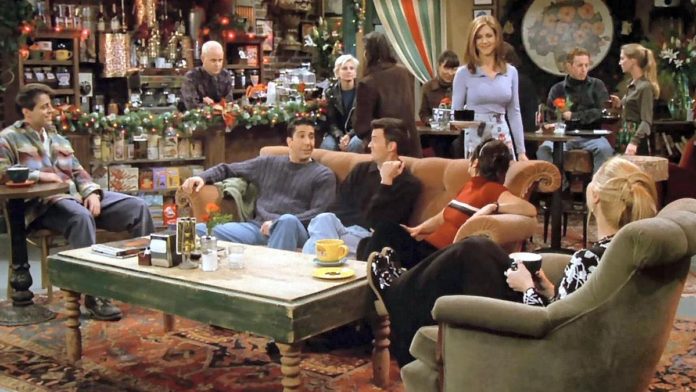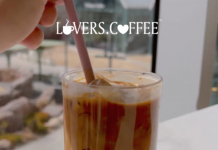As many of us coffee-addicts were in our childhood or young teens during the 1990s, the television our older siblings and parents watched would, of course, rub directly onto us. I remember loving all those shows and continue to watch them even over twenty years later. In North America especially, the popularity of television characters spending most of their free time drinking coffee boomed in the 90s. We wanted to be like the group of friends who met and discussed their love lives on an old couch that no one else ever sat in.
My question is: did the makers of these popular television shows intend on making us grow the “coffee house” scene and stray away from the popular bar scenes that many earlier shows (think “Cheers”) often promoted? How did the 90s sitcoms influence the rise and our love for coffee shops?
It may even have been deliberate. In 2017, a radio presenter named Alex Baker came up with an interesting theory, calling the rise in coffee shop television as “a mad, elaborate stage-setter for Starbucks” and a “meticulously-planned priming exercise to manipulate human behaviour.” Although this is a little intense, it’s true that Starbucks boomed during the mid-1990s, bouncing from 85 to over 3500 locations by the year 2000.
There were 3 shows in particular that opened up the scene for coffee shop popularity across North America.
Friends.

With almost 53 million people who watched the series finale back in 2004, Friends was once and still is one of the most beloved sitcoms of all time. Central Perk, the neighborhood cafe where the six besties spent most of their free time, was seen in almost every episode of the show. It was the setting of many crucial (and tear-jerker) moments and many more cups of coffee. It’s no secret that Friends highly influenced the lives of millions of people.
An article on Vice blames Friends for the rise in coffee shops and the type of people who often frequent them, and not in a positive way. “when [Friends] was first shown, coffee shops must have seemed kind of sophisticated and glamorous. Unlike bars or greasy diners, they are a place for both work and fun, somewhere you could talk to your buddies without old frat boys shouting at TV screens. Now that you can get a decent espresso at the airport or McDonald’s, they’ve lost some of that exoticism.
However, the coffee-shop dicks remain. Staying longer and longer than before due to Wi-Fi and the widening of the market. Still dramatically sighing at kids who make noise, still talking about job interviews, still reading the same books, and still failing to finish the same terrible, terrible screenplays.”
Frasier.

The Seattle-based “Cheers” spin-off of Frasier Crane and his luxurious life as a radiotherapist often held important communication scenes in the nearby Cafe Nervosa (not to be confused with the name Cafe Insomnia, which if you’re a deep Friends fan, was the first working title of the show). Frasier was a delightfully funny show that again pulled our heartstrings and made us long for his sophisticated lifestyle – which could have led us into similarly styled coffee shops.
In support of the above theory that 90s sitcoms aimed to steer people away from bars and into coffee shops, Frasier clearly gave up his interest in spending time with his friends at Cheers and instead focused on the benefits of coffee as a possible recovering alcoholic.
In an interesting scene from season 10 called “Goodbye, Nervosa”, Frasier enters the newly renovated Cafe and is struck with its obvious similarity to Starbucks. After ordering a large black coffee because of an “ethical dilemma”, the barista says that the only sizes they have are “piccolo, macho, mucho, and mucho macho.” The audience laughs, yet Frasier plays along with the scene completely, trying to figure out which size would correlate properly. We are left, however, feeling a little foolish for the craziness that coffee shops had become as Frasier drops down into his bean bag to wait for his cup of coffee.
Seinfeld.

Saving Seinfeld for last, this sitcom completely changed the face of television. Instead of shows having an absolute purpose, Larry David created this piece of art as a foundation for shows that didn’t need to be about anything – much of what Friends tended to take inspiration from.
Monk’s Cafe was the frequent location for Jerry Seinfeld and his friends to have lunch, coffee (of course) and discuss the completely ludicrous notions that they often mulled over. Although there were inconsistencies as to whether Monk’s was a cafe or a restaurant (which the outside images of the real eatery “Tom’s” implied), there was no denying that Monk’s promoted friendly conversation and coffee strong enough to keep up with the antics of the characters.

Funnily enough, Jerry Seinfeld later developed his currently popular Netflix show “Comedians in Cars Getting Coffee” which may be a nod to the fact that he and his equally hilarious co-stars (who have been on the Netflix show) were often seen drinking coffee at Monk’s Cafe.
Regardless of how 90s sitcoms influenced our growing up during the age of booming coffee shops, they’ve also grown on the younger generation as well, which may have actually killed the idea of a friendly coffee house meet up for Millenials. The increase in the streaming of the above shows on popular platforms may have also influenced our younger counterparts. It’s tough to even walk into any Starbucks or even local coffee shops (especially if they’re anywhere within walking distance of a college) and be able to find a seat.
Thanks to the free wifi and most owners who don’t fret over who has been sitting for hours warming the old wooden chairs and couches, many of us either take our coffee to go or brave the craze. Regardless of how we get our coffee, we do know that Americans love coffee. Over 64% of us drink coffee daily while the average person spends over $1,100 a year. We won’t even say anything negative about our favorite “friends”, because they know we love those guys. So, thanks for being there for us.
What’s your favorite TV coffee house? Let us know in the comments.






I have fun with, cause I found exactly what I used to be having a look for.
You’ve ended my four day lengthy hunt! God
Bless you man. Have a great day. Bye